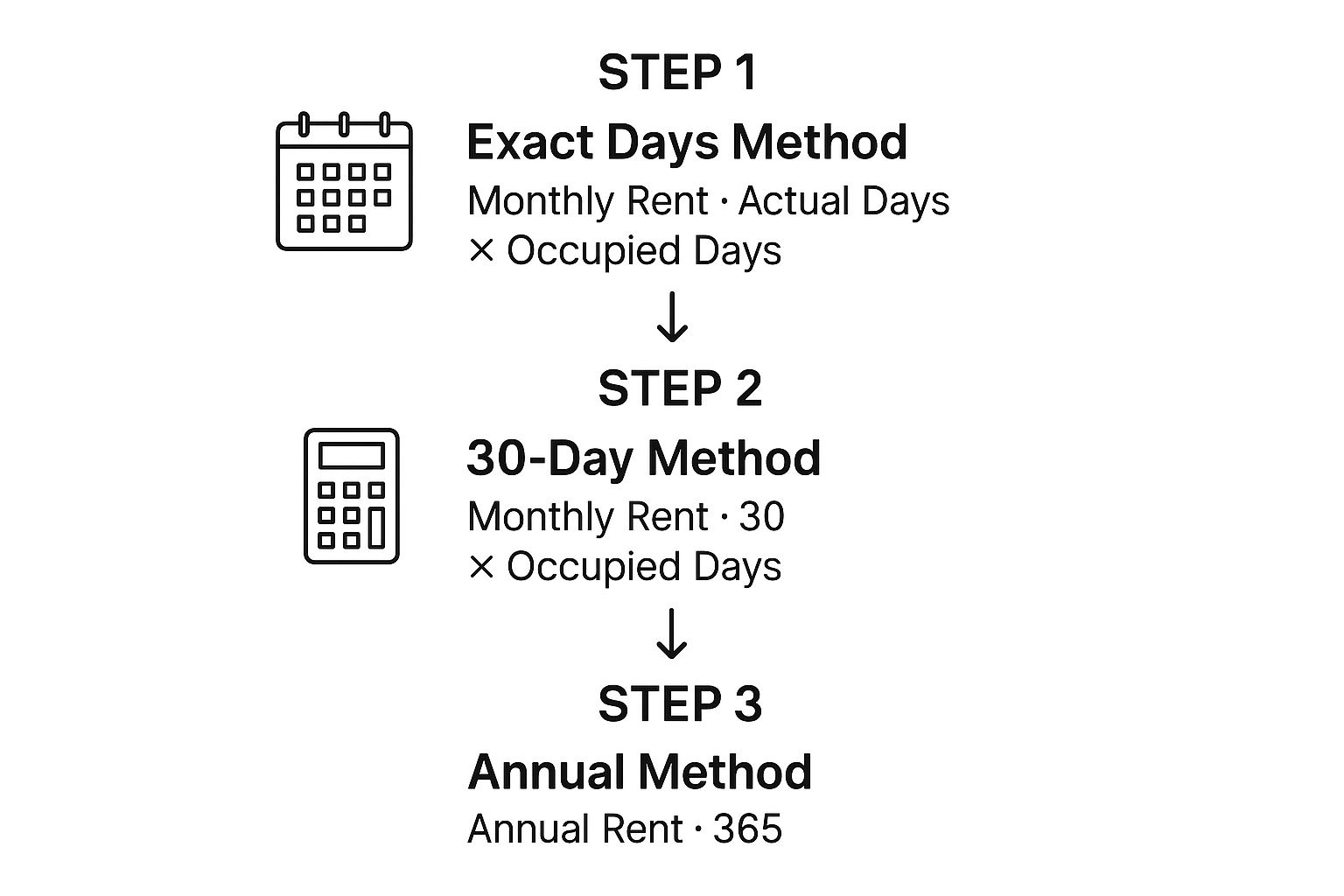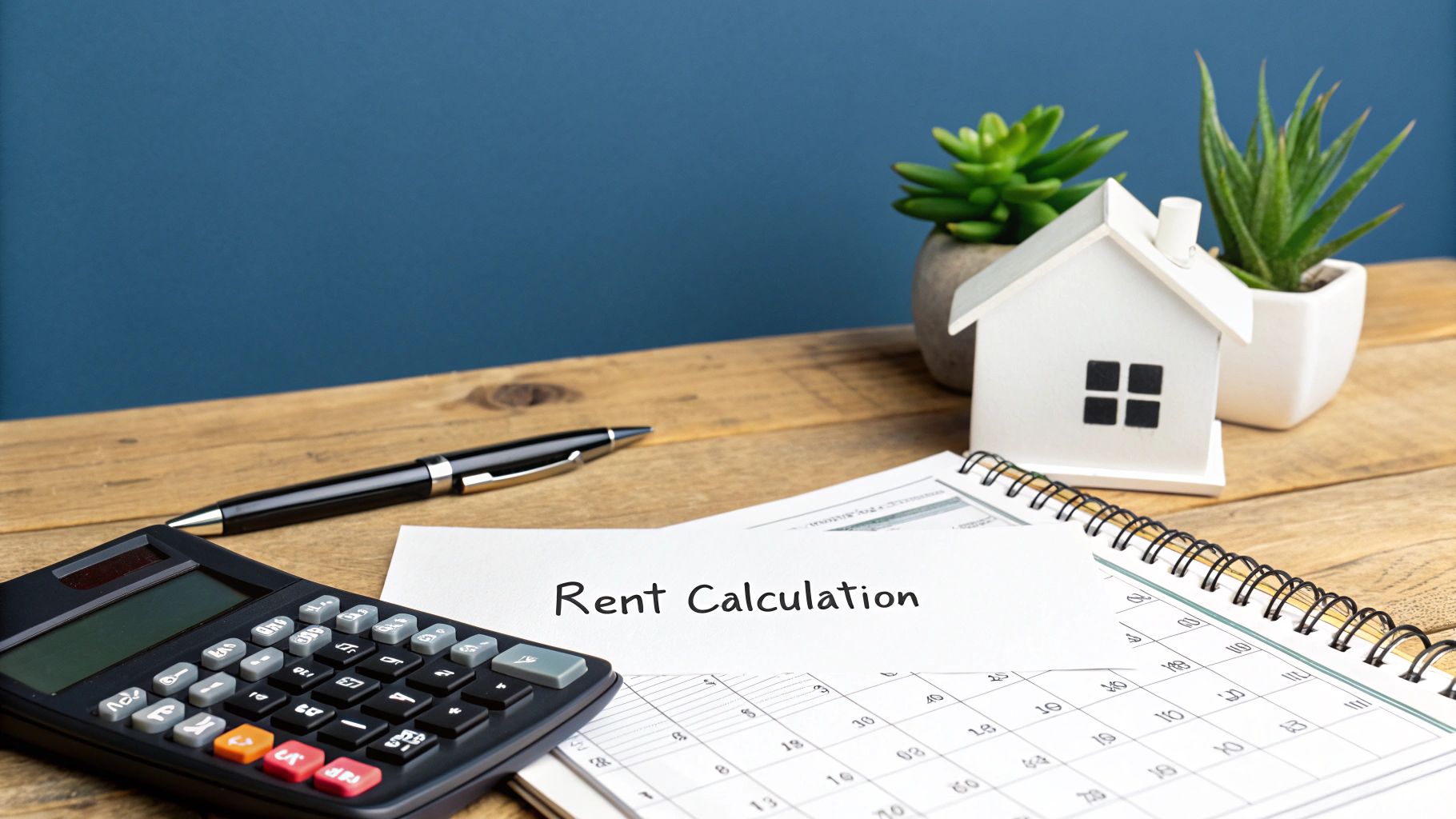Calculate Prorated Rent with Confidence
- Sarah Porter

- 2 days ago
- 9 min read
Prorated rent is a straightforward concept: you only pay for the specific days you live in a property during a partial month. Instead of being on the hook for a full month's rent, you’re charged a proportional amount that lines up with your move-in or move-out date.
It's all about fairness, making sure you only pay for the time you're actually using the space.
Why Prorating Rent Matters

Knowing how to calculate prorated rent is a game-changer for both tenants and landlords. It sets a fair and transparent tone right from the start, which helps prevent a lot of potential headaches and disagreements later on.
Common Scenarios For Prorated Rent
You’ll most often see prorated rent come into play when a lease doesn't start or end neatly on the first or last day of the month. Here’s a quick look at the most common situations.
Scenario | When It Applies | Who Benefits |
|---|---|---|
Mid-Month Move-In | A tenant's lease begins on a day other than the first. | Tenant: Avoids paying for days before they had access to the property. |
Early Lease Termination | A tenant moves out before the month ends (with landlord approval). | Tenant: Only pays for the days they occupied the unit that month. |
Lease Changeover | A lease ends mid-month and a new one begins immediately. | Both: Ensures a smooth financial transition between leases. |
These scenarios are pretty standard in most rental markets. Think about it: with the national median rent sitting around $1,394 per month, if a tenant moves in on the 15th of a 30-day month, they'd pay half of that—just $697. That’s a significant and fair adjustment that directly impacts the finances of everyone involved.
The core idea is simple: pay for what you use. Prorating rent takes the guesswork out of the equation and makes sure the rental agreement is fair for both the landlord who needs to cover their mortgage and the tenant who deserves an honest charge.
Ultimately, any good lease agreement should have a clear clause explaining how prorated rent is handled. If you're reviewing a lease and don't see it mentioned, bring it up with the landlord before you sign anything. For a great example of how this should look, you can always download our rental lease agreement template to see how these clauses are usually worded. Taking that one extra step helps build a positive landlord-tenant relationship from day one.
Getting the Prorated Rent Math Right
When it comes to calculating prorated rent, there’s no single, legally mandated formula everyone has to follow. Landlords generally pick one of a few common methods. Knowing how they work is the best way to double-check the math and make sure you’re paying the right amount.
The differences between these formulas can seem pretty minor at first glance, but they can add up to slightly different final numbers. This becomes especially noticeable in competitive rental markets where every dollar counts. For example, with the median rent in the United States hovering between $1,400 and $1,450 recently, the specific calculation method can definitely impact that first payment. You can actually explore U.S. rental market trends to see how these figures change over time.
Let's break down the three most common ways landlords figure this out.
The Most Common Method: Using the Exact Number of Days in the Month
This is the approach you’ll see most often. It's widely considered the fairest and most transparent way to calculate prorated rent because it’s tied directly to the calendar month you're moving in.
Here’s the simple formula:
(Monthly Rent / Number of Days in That Month) x Number of Days You'll Be There = Prorated Rent
Let’s run a quick example. Say your rent is $1,500 a month and you get the keys on April 11th. April has 30 days, so you'll be living in the apartment for 20 of them (from the 11th to the 30th).
First, find the daily rate for April: $1,500 / 30 days = $50 per day
Then, multiply by the days you're there: $50 x 20 days = $1,000
Your prorated rent for April comes out to a clean $1,000. The beauty of this method is its precision—it accounts for the fact that February is shorter than March.
The Standardized Method: Using a 30-Day "Banker's Month"
Some landlords and property management companies prefer a more uniform approach. To keep things simple on their end, they calculate the daily rate as if every month has exactly 30 days, no matter what the calendar says.
The formula looks almost identical, just with one key change:
(Monthly Rent / 30) x Number of Days You'll Be There = Prorated Rent
Let's use our $1,500 rent again, but this time, imagine you're moving in on March 11th. March actually has 31 days, so you’ll be there for 21 days.
The standard daily rate is: $1,500 / 30 days = $50 per day
Now multiply by your days: $50 x 21 days = $1,050
This method is all about consistency, making the bookkeeping a little easier since the daily rent cost never changes from month to month.
Key Takeaway: The main difference between these first two methods is the daily rate. When you use the exact number of days, the daily rent is higher for short months (like February) and lower for long ones (like August).
The Big Picture Method: The Annual Calculation
Though less common, this method is just as legitimate. It involves calculating a daily rent based on the entire year, which completely smooths out any monthly variations.
Here’s how you’d calculate it:
((Monthly Rent x 12) / 365) x Number of Days You'll Be There = Prorated Rent
Let's stick with our $1,500 rent and the April 11th move-in (which means you're there for 20 days).
First, find the annual rent: $1,500 x 12 months = $18,000
Next, get the annual daily rate: $18,000 / 365 days = $49.32 per day
Finally, calculate the total: $49.32 x 20 days = $986.40
As you can see, this approach often results in a slightly lower prorated amount. Just a small tip: if it happens to be a leap year, you'll want to use 366 days for the most accurate calculation!
This infographic gives a great visual breakdown of how each of these three methods works.

It clearly shows that while each formula starts with your rent, the number used to divide it—the actual days in the month, a standard 30 days, or 365 days—is what leads to the slightly different outcomes.
Calculating Your Rent: A Real-World Walkthrough

The theory behind prorated rent is simple, but running the numbers yourself is where it really clicks. Let’s break down a common move-in situation to see exactly how this works in practice. We'll use the most popular method—calculating based on the actual number of days in the month—so you can feel confident double-checking the figures on your own lease.
Let's say your new place has a monthly rent of $1,500, and you're set to move in on October 20th. Your landlord has already agreed to prorate the first month.
Here's the step-by-step math.
First, we need to figure out the daily rent cost. Since October has 31 days, the calculation is:
$1,500 (Monthly Rent) ÷ 31 (Days in October) = $48.39 per day
Next, you count how many days you'll actually be in the apartment for October. Moving in on the 20th means you’ll be there for 12 days (from the 20th through the 31st).
Now, just multiply the daily rate by the number of days you'll be there.
$48.39 (Daily Rate) x 12 (Days of Occupancy) = $580.68
So, your prorated rent for that first partial month comes out to $580.68.
What About a Move-Out Scenario?
The logic works the exact same way when you're moving out. Let's imagine you're leaving an apartment that costs $1,800 a month, and your lease officially ends on June 10th.
We'll start by finding the daily rent for June, which has 30 days.
$1,800 (Monthly Rent) ÷ 30 (Days in June) = $60.00 per day
Since your responsibility ends on the 10th, you owe for those first 10 days of the month.
$60.00 (Daily Rate) x 10 (Days of Occupancy) = $600.00
Your final prorated rent payment for June would be a clean $600.00.
Keep in mind that prorating rent for a move-out often depends on your lease agreement and whether you've given proper notice. Always confirm the policy with your landlord to avoid any surprises.
Nailing this calculation is a key part of a smooth move, just like using a solid checklist to stay organized. For more tips, check out our guide on the ultimate move-in and move-out checklist. Understanding this simple math ensures you only pay for the time you're actually there, making your move financially fair and transparent.
Making Prorated Rent Work for You: Tips for Tenants and Landlords

When it comes to prorated rent, a little communication and a clear understanding can go a long way. Whether you're the one moving in or the one managing the property, a few simple practices can keep things smooth and prevent headaches down the road.
If you’re a tenant, your best friend is the written word. Before you even think about signing the lease, make sure that prorated rent amount is spelled out clearly in the agreement or a separate addendum. It’s a simple step, but having that paper trail protects everyone involved.
It also never hurts to run the numbers yourself. Take a moment to calculate the prorated rent using one of the standard formulas to be sure it lines up with what your landlord has presented.
Best Practices for Landlords
For property owners, the name of the game is consistency. Pick one fair method for calculating prorated rent and apply it across the board for all your properties. This not only makes your life easier but also ensures you're treating every tenant equitably.
A few pointers I always give to landlords:
Pick a Lane and Stay in It: Decide if you’ll use the actual days in the month or an average 30-day month for your calculations. Whichever you choose, stick with it.
Keep Meticulous Records: Document every prorated rent calculation and conversation. This isn't just good practice; it's essential for sound financial management.
Embrace Transparency: If a tenant asks how you got to a specific number, be ready to show them the math. A little openness builds a lot of trust.
I can't stress this enough: clear and accurate financial records are non-negotiable for landlords. It makes handling one-off situations like prorated rent a breeze, but it's also crucial for tracking your investment's performance and simplifying tax time.
Getting these details right is a hallmark of a professional landlord. If you want to sharpen your skills in this area, our guide on bookkeeping for rental properties made simple is a great place to start.
Still Have Questions About Prorated Rent?
Even when you've got the formula down, real-life situations can throw a wrench in the works. Let's walk through some of the questions that pop up most often for both tenants and landlords.
Getting these things cleared up ahead of time is the best way to avoid confusion or a last-minute disagreement. A good rental experience really comes down to clear communication and knowing what to expect from the get-go.
Do Landlords Have to Prorate Rent by Law?
This is a big one, and the short answer is: not always. While prorating rent is a common courtesy and a standard business practice, it’s not legally required everywhere. Landlord-tenant laws can differ wildly from one state or city to the next.
Some places have local rules that mandate it, but in many others, it all hinges on what's written in the lease agreement. This is exactly why it’s so critical to read every line of your lease before signing.
My Advice: Always look up your local landlord-tenant laws. More importantly, see what your lease says about it. If proration isn't mentioned, that’s something you need to discuss and get in writing before you commit.
How Does a Leap Year Change the Calculation?
Figuring out rent for February in a leap year seems tricky, but it's actually pretty straightforward. You use the exact same process but just account for the extra day. Instead of dividing the monthly rent by 28, you'll divide it by 29.
Let's imagine the rent is $1,200 a month and you move in on February 20th during a leap year.
First, get the daily rate: $1,200 / 29 days = $41.38 per day.
Next, multiply that by the number of days you'll be there (in this case, 10 days): $41.38 x 10 = $413.80.
So, your prorated rent for that first month would be $413.80. The method doesn't change, just the number of days you use for that specific month.
Is the Security Deposit Also Prorated?
Absolutely not, and this is a really important distinction to make. A security deposit is never prorated. It's a one-time, separate payment that's there to cover any potential damages to the unit, not to pay for your time living there.
The deposit is a fixed amount—usually equal to one full month's rent—and you have to pay the whole thing no matter when your lease starts. It's held separately and has nothing to do with your actual rent payments.
At Keshman Property Management, we've been sorting out these kinds of details for over 20 years. We make sure every financial aspect of your property is handled correctly and clearly. Learn how we can make your life as a property owner easier.

Comments